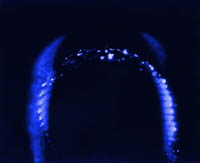Kirlian Photography

Kirlian photo of a finger
Kirlian photography is a type of contact print photography in which an object touching a photographic plate is connected to a high voltage source, creating an aura-like image. It is named after Russian inventor Semyon Kirlian (1898 – 1978), who accidentally discovered the technique in 1939.
How it Works
An object is placed in contact with a photographic plate and connected to a source of high voltage, high frequency, low current electricity (the low current makes it harmless). Small coronal discharges are created by the strong electric field at the edges of the object. The frequency of the electricity excites electrons in the object so they ionize the surrounding air.
Objects must be conductive for this technique to work. The object can be moist (e.g. a living thing) or conductive metal. A dry non-conducting object will not produce the effect.
Paranormal (Auras)
Kirlian photography is often confused with aura photography. Although the similarities are obvious, they are two very different techniques. In aura photography there is no voltage and no direct contact with the photographic plate.
Many paranormal enthusiasts still claim that the aura captured by Kirlian photography is some sort of "life force". However this is easily debunked:
- Kirlian photographs can be taken of anything moist or conductive, including coins, paper clips, etc.
- Kirlian photographs taken in a vacuum (where no ionized gas is present) show no aura.
- Some people claim that a living object slowly loses its aura after it dies. This is more easily explained by the fact that it loses its moisture.